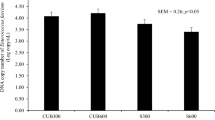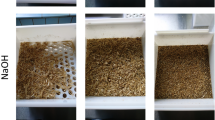Abstract
CHROMIUM sesquioxide (Cr2O3) is widely used for estimating feed digestibility1 or fæces output2 by ruminants, but such estimates may be subject to considerable errors because the concentration of this marker in fæces normally shows considerable diurnal variations even after prolonged regular administration. These variations are particularly obtrusive with grazing animals where the chromium sesquioxide, in this case used for estimating the output of faeces, is usually administered in concentrated powder form in gelatin capsules once or twice daily, and they probably arise primarily from an imperfect mixing of the oxide with digesta in the reticulo-rumen3,4. This view is supported by unpublished observations (by J. F. D. Greenhalgh) on the concentrations of chromium sesquioxide in the organic matter of digesta obtained from the duodenum of a sheep permanently cannulated at this point. As the variations in concentration during a period of regular dosing showed the same pattern and were greater than those found in the fæces, it was decided to study in a comparably cannulated sheep the passage of single doses of oxide powder, each given in a gelatin capsule and in amount large enough to give measurable concentrations over a considerable period of time. Samples of digesta were drawn from the duodenum at intervals beginning 1 hr. after dosing. Results from a typical run where 8 gm. were given are shown in Fig. 1 (line A) and indicate that a large part of the dose had passed from the stomachs within 4 hr. of administration. The probable explanation is that the capsule container dissolved quickly in the anterior rumen or reticulum3 and that local concentrations of chromium sesquioxide in these regions4 were rapidly transferred through the reticulo-omasal orifice.
This is a preview of subscription content, access via your institution
Access options
Subscribe to this journal
Receive 51 print issues and online access
$199.00 per year
only $3.90 per issue
Buy this article
- Purchase on Springer Link
- Instant access to full article PDF
Prices may be subject to local taxes which are calculated during checkout
Similar content being viewed by others
References
Edin, H., Kihlen, G., and Nordfeldt, S., LantbrHogsk. Ann., 12, 166 (1944).
Raymond, W. F., and Minson, D. J., J. Brit. Grassl. Soc., 10, 282 (1955).
Balch, C. C., Reid, J. T., and Stroud, J. W., Brit. J. Nutr., 11, 184 (1957).
Corbett, J. L., Greenhalgh, J. F. D., Gwynn, P. E., and Walker, D., Brit. J. Nutr., 12, 266 (1958) and unpublished observations.
Edin, H., Fran Centralanstalten för försöksväsendet pȧ jordbruksomrȧdet. Husdjursavdelningen No. 50 Med. 309 (Stockholm, 1926).
Pigden, W. J., and Brisson, G. J., Canad. J. Anim. Sci., 37, 185 (1957).
Kane, E. A., Jacobson, W. C., and Moore, L. A., J. Nutr., 47, 263 (1952).
Author information
Authors and Affiliations
Rights and permissions
About this article
Cite this article
CORBETT, J., GREENHALGH, J. & MACDONALD, A. Paper as a Carrier of Chromium Sesquioxide. Nature 182, 1014–1016 (1958). https://doi.org/10.1038/1821014b0
Issue Date:
DOI: https://doi.org/10.1038/1821014b0
Comments
By submitting a comment you agree to abide by our Terms and Community Guidelines. If you find something abusive or that does not comply with our terms or guidelines please flag it as inappropriate.



